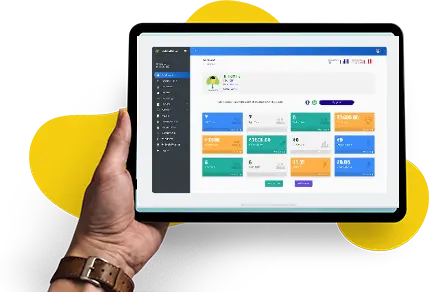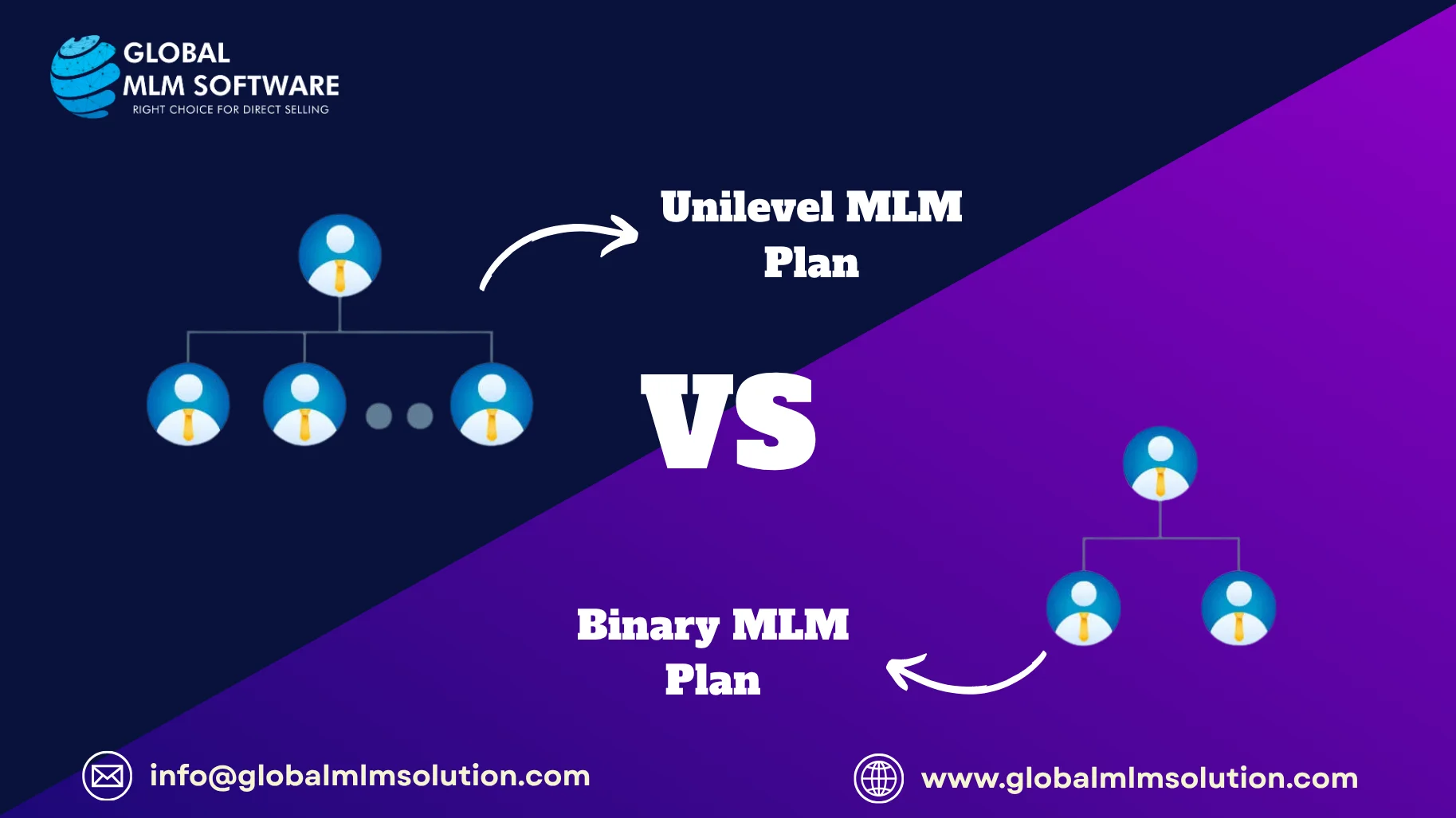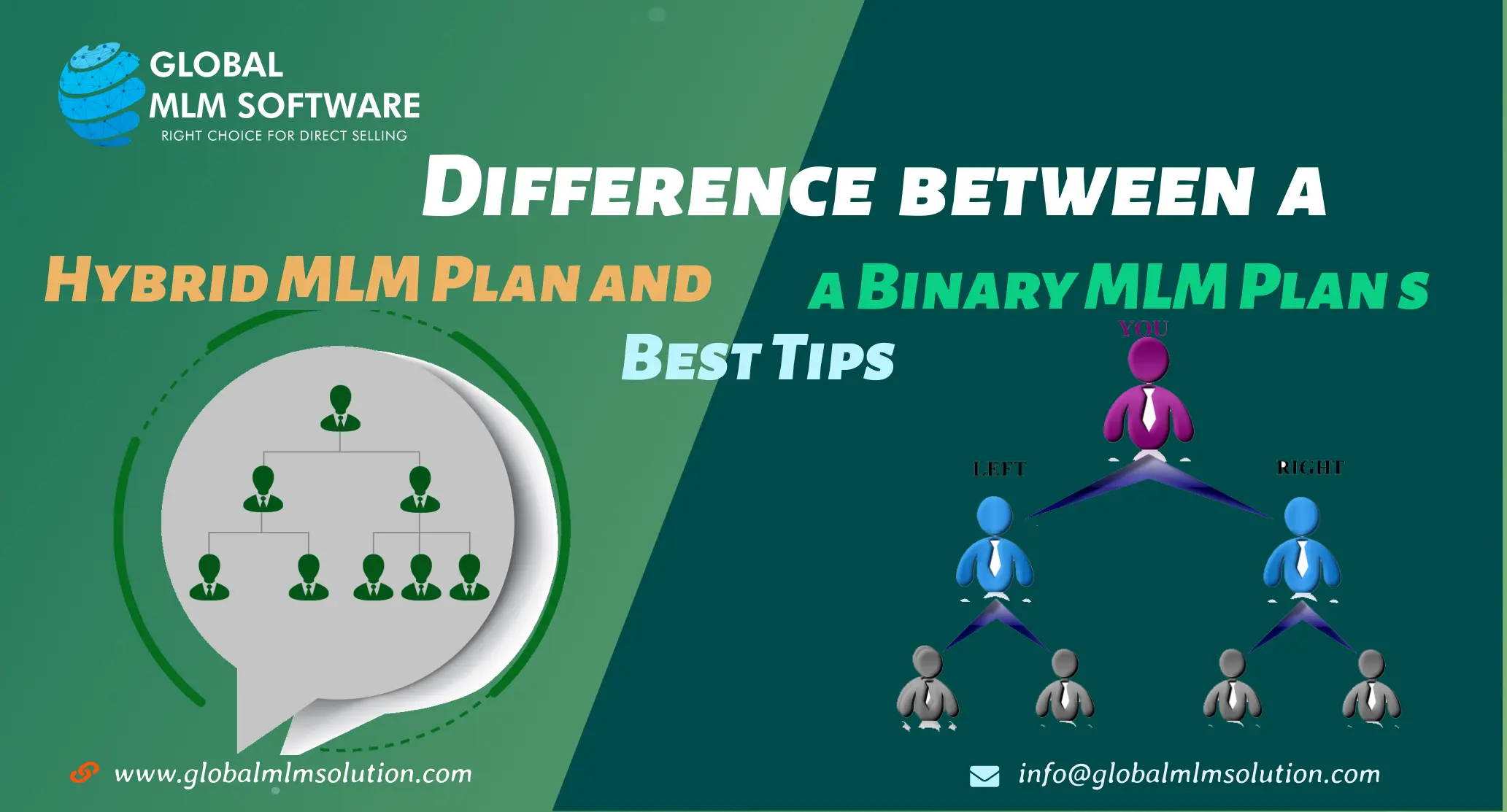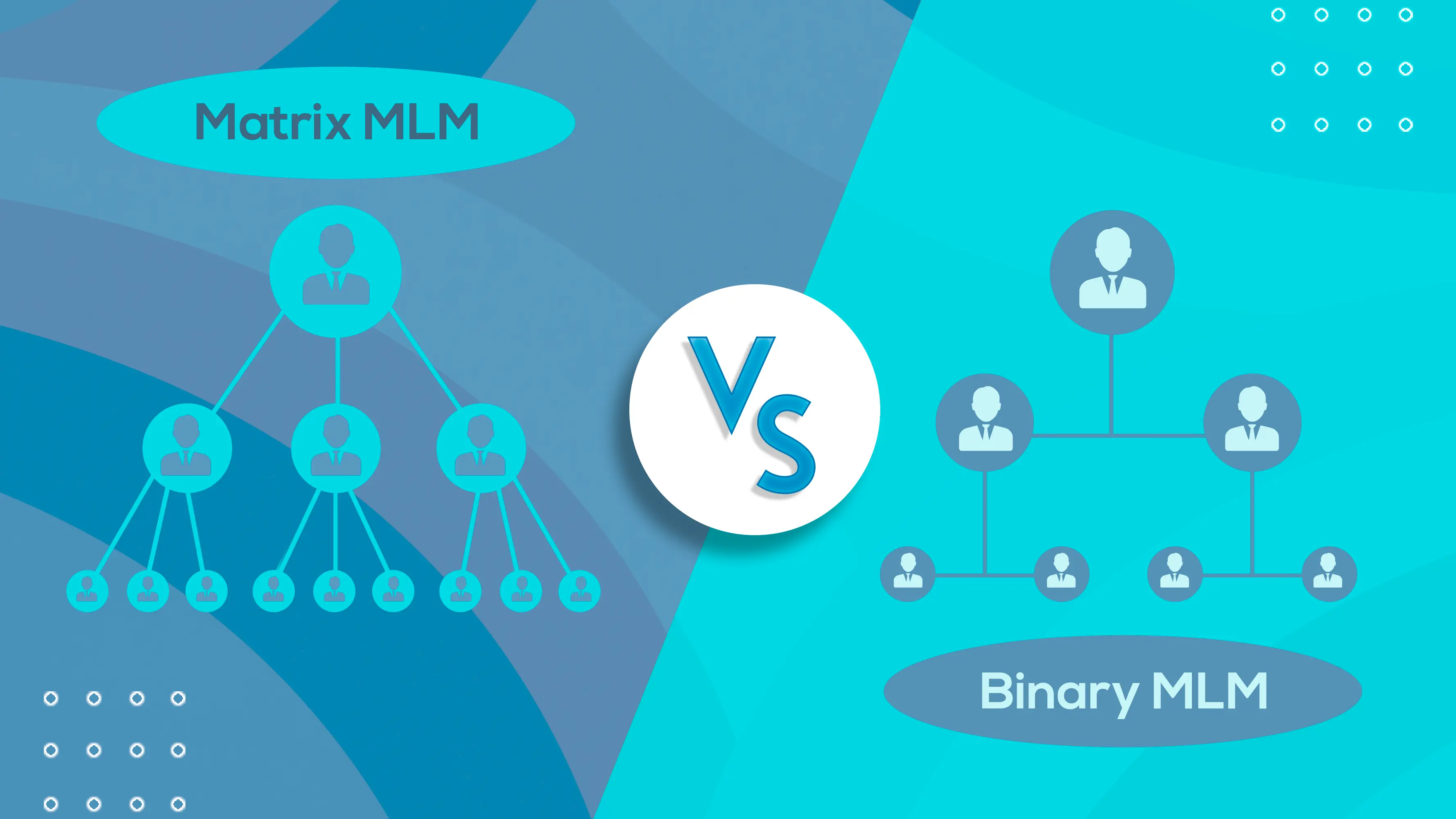Are you looking for the right compensation plan and aren’t sure what is the difference between Binary and Generation MLM Plan? Don’t worry, we’ll help you understand it!
The Binary Plan helps businesses grow faster with its simple two-leg structure. On the other hand, the Generation Plan focuses more on sales performance and rewards distributors based on the sales made within each generation group.
But that’s just the tip of the iceberg. There’s much more to how both plans work, what makes them unique, and which one suits your business goals better. We’ve broken it all down for you in our Binary MLM Plan vs Generation MLM Plan blog so you can make an informed and confident choice for your business journey.
This Article Contains:
What is a Binary MLM Plan?
A Binary MLM plan is a two-branch structure where every person has only two frontline positions, creating a left leg and a right leg. There’s no limit on how deep the organization can grow on both legs. Commissions are based on sales volume collected in each leg. The pay is typically computed from the lower-volume leg, known as the pay leg, while the higher-volume leg serves as the reference leg.
The lower volume leg (pay leg) determines commissions in a Binary MLM plan for balance, sustainability, and motivation. This structure encourages a balanced effort across both legs and prevents the company from overpaying on an infinitely deep, high-volume leg.
Let’s examine how Binary MLM plan works:
Each time a distributor sponsors a new person, that person is placed either on the left leg or the right leg. After the first two placements, extra recruits “spill over” and are placed further down the tree under existing team members, which supports teamwork and unlimited depth. This structure encourages balancing both legs, because earnings depend on building volume on both sides rather than only one side.
Commission calculation example:
Many binary plans pay commission based on sales volume (SV) from the pay leg. That means if the left leg has 300 SV and the right leg has 200 SV in a period, the commissionable volume is 200 SV from the weaker leg.
Many MLM companies often set “capping” rules so that only up to a set SV or income amount is paid in a cycle. Any extra volume may be flushed or limited based on the plan’s rules. Because pay is tied to the weaker leg, teams work to balance both sides so more of the total volume counts toward commissions.
Companies using Binary plans include:
USANA
Isagenix
What is the Generation MLM Plan?
A Generation MLM Plan is a pay plan where your team is organized into “generations.” Each generation is a group made of one distributor and that distributor’s customers as a single unit. The Generation plan is ideal for companies that focus heavily on product sales, such as e-commerce brands.
Here’s how Generation MLM plan works:
In a Generation plan, a distributor and the distributor’s customers are grouped as one unit called a generation. This structure helps separate customer sales from downline team building. As in a downline, some people buy as customers and never recruit.
So instead of mixing distributors and customers together, the generation MLM plan creates groups, which consist of one distributor as leader and his/her customers. If a happy customer upgrades to become a distributor, they can start building their own team and may later form a new generation when they reach the required rank.
When someone in your team reaches a set rank or leadership level, that person and their own team become a new generation. So, rewards are organized by generations instead of just levels. This design seems similar to a unilevel plan, but it isn’t because generations are formed by rank and leadership, not only by how far someone sits under you in the tree.
Example:
Distributor A serves customers Mia, Dev, and Noor, and this whole group is tracked together as Generation 0 to keep customer sales separate from team-building work.
Distributor A sponsors two new distributors, Riya and Omar, who begin building teams. They do not become their own generation until they reach the company’s leadership ranks.
Let’s suppose Riya qualifies at the set rank, so “Riya + Riya’s customers” now becomes Generation 1 under Distributor A for leadership rewards.
Further, Omar also qualifies, so “Omar + Omar’s customers” becomes Generation 2 under the distributor.
Later, Rahul (let's suppose Riya’s customer) becomes a distributor and qualifies for the rank. So “Rahul + Rahul’s customers” becomes Generation 3 under Distributor A, even though Rahul sits deeper in the tree.
Therefore, Distributor A has a clear genealogy tree of his/her downline and the customers.
Major Differences Between Binary and Generation MLM Plan
Apart from the foundational level differences between binary and generation MLM plans, there are other aspects where both function distinctively.
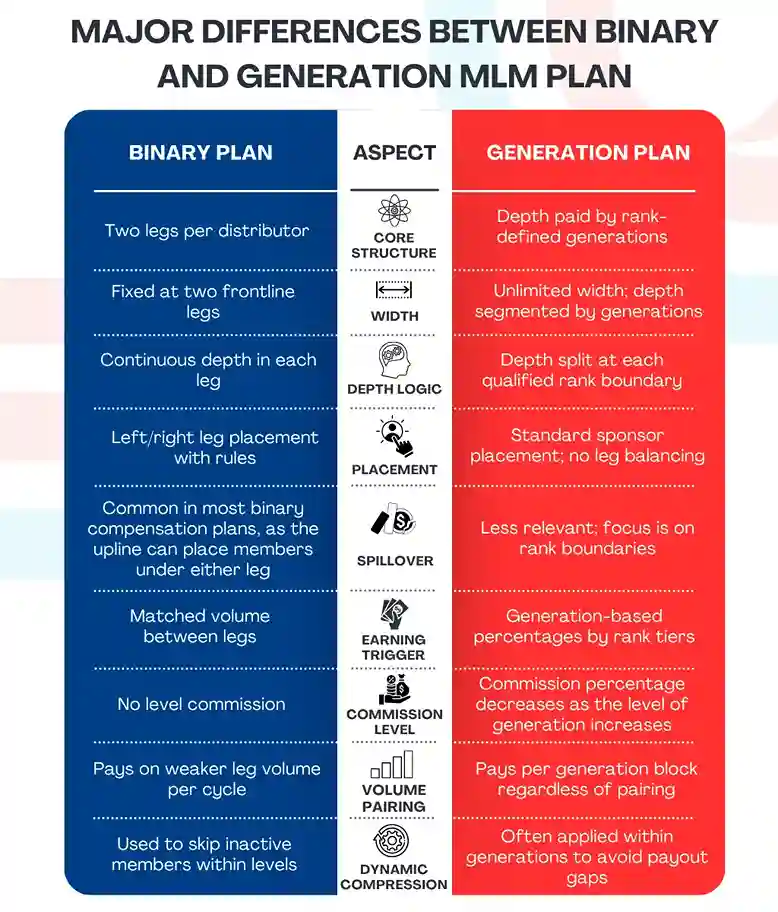
| Aspect | Binary Plan | Generation Plan |
|---|---|---|
| Core structure | Two legs per distributor. | Depth paid by rank-defined generations. |
| Width | Fixed at two frontline legs. | Unlimited width; depth segmented by generations. |
| Depth logic | Continuous depth in each leg. | Depth split at each qualified rank boundary. |
| Placement | Left/right leg placement with rules. | Standard sponsor placement; no leg balancing. |
| Spillover | Common in most binary MLM compensation plans, as the upline can place members under either leg. | Less relevant; focus is on rank boundaries. |
| Earning trigger | Matched volume between legs. | Generation-based percentages by rank tiers. |
| Commission level | No level commission. | Commission percentage decreases as the level of generation increases. |
| Volume pairing | Pays on weaker leg volume per cycle. | Pays per generation block regardless of pairing. |
| Dynamic compression | Used to skip inactive members within levels. | Often applied within generations to avoid payout gaps. |
Which One to Choose?
If speed and simplicity matter most, choose a Binary compensation plan. Its two-leg structure is clear, scalable, and rewards balanced team volume. Binary pays from the weaker pay leg, encouraging a steady left-right balance. If product leadership and coaching matter most, choose a Generation compensation plan. It groups one leader with customers and pays overrides by generation blocks.
Before deciding, map goals, profit margins, compliance, and field training capacity. Start by testing with actual sales data, then precisely adjust the ranking criteria, earning limits, and eligibility requirements.
Whichever plan you select, always deploy feature-rich Binary MLM software and Generation MLM software for seamless business operations and transparent payouts. It automates genealogy tree generation, volume pairing, generation overrides, rank advancements, and commission engines. As a SaaS provider serving 400+ companies, we witness software-driven growth every day. It handles spillover, wallets, taxes, dashboards, analytics, and mobile operations effortlessly.
FAQs
1. How do I decide between a Binary MLM Plan and a Generation MLM Plan for my business?
Decide by matching your growth goals, sales model, and team capacity. Both plans work, but they fit different strategies and behaviors. Choose Binary if you want a simple two‑leg structure and fast recruiting. Binary pays from the weaker “pay leg,” so keep both legs balanced.
Spillover can help depth, but consistent sponsoring still drives results. Choose Generation if you prioritize product sales and leadership overrides. Generations form when leaders rank‑qualify, grouping one leader with customers. This keeps retail activity clear and rewards coaching across generations.
2. What are the common misconceptions about the Binary MLM Plan?
The common misconceptions about the Binary MLM plan include:
You can keep adding many frontline members: In Binary, you only have two frontline positions, left and right.
Spillover will build my income for free: Spillover may add people, but pay still needs balanced legs and coaching.
Only the strong leg matters: Most plans pay from the weaker pay leg, so balance both sides.
Binary is a pyramid scheme: Legal Binary plans sell real products and follow compliance rules.
Pay is unlimited with no limits: Plans use caps, carryover, or flush rules to control payouts.
Commissions are simple level percentages: Binary uses weak-leg volume and pairing, which is more complex.
You can only recruit two people ever: You may sponsor more; extra recruits place deeper under your downline.
Imbalances cannot be fixed: Some plans use volume carryover to help manage leg differences.
3. What are the common misconceptions about the Generation MLM Plan?
The common misconceptions about the generation MLM plan are:
It is “just unilevel”: In a Generation plan, a new generation starts when a leader reaches a set rank, not by level depth.
Customers and distributors are mixed on one level: Generations keep one qualified leader with their customers in one clear group for neat tracking.
Everyone becomes a new generation at sign-up: A new generation starts only when the person qualifies at the required rank.
Only people at the top get paid; it is a pyramid scheme: Real MLMs pay for product sales and follow clear rules, not for recruiting alone.
Retail sales do not matter: Retail sales matter a lot; Generation plans highlight customer orders and fair rewards.
Money comes easily without coaching: Leaders still coach teams, set goals, and support results to earn overrides.
Disclaimer: Global MLM Software do not endorse any companies or products mentioned in this article. The content is derived from publicly available resources and does not favor any specific organizations, individuals or products.




